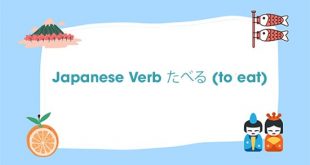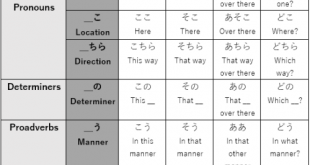How to Make Japanese Verbs て-form (te-form)? How to make te-form from Masu form in Japanese Language… How to form the “te-form” The “te-form” is a one of Japanese verb’s conjugation and te-forms are very important part of Japanese grammar. All the verbs presented so far have been in, or …
Read More »Learn Japanese
What is the passing N1, N2, N3, N4, N5 score for the JLPT Exam?
What is the passing N1, N2, N3, N4, N5 score for the JLPT Exam How many points does it take to pass N1, N2, N3, N4, N5 of the JLPT exam? The results of the JLPT Japanese Language Proficiency Test are out, but many people don’t know how to …
Read More »A brief introduction to Japanese language
A brief introduction to Japanese language Japanese (日本語 Nihongo, [nihoŋɡo]) is a language spoken by over 120 million people in Japan and in Japanese emigrant communities. It is a member of the Japonic (or Japanese-Ryukyuan) language family, which has a number of proposed relationships with other languages, none of which …
Read More »Japanese grammar is difficult but useful
Japanese grammar is difficult but useful ちょっと難しい文法が役に立つ Kinda difficult grammar will help Related Post: Essential Japanese Grammar Useful Japanese Grammar with Examples – Part 1
Read More »How using しらない / わからない
How using しらない / わからない Are you using it correctly? Related Post: How to say Time in Japanese How to talk about Duration in Japanese
Read More »How to make て-form?
How to make て-form? Related Post: 100 Basic Japanese Words for Beginners Basic Japanese Particles
Read More »What is the difference between: どこかで and どこかに
What is the difference between: どこかで and どこかに (Somewhere / Anywhere / Where ) Today I’m going to talk about the difference between どこかで and どこかに in Japanese! The two particles that you see (で and に) change the meaning of both these words that otherwise seem very similar! And …
Read More »Japanese Verb たべる (to eat)
Japanese Verb たべる (to eat) General: Meaning: To eat Kanji: 食べる Hiragana: たべる Particles: (object) を Conjugation: ( type: verb, positive・ verb, negative ) Present, plain: たべる・たべない Present, polite: たべます・たべません Past, plain: たべた・たべなかった Past, polite: たべました・たべませんでした Te-form: たべて Potential, plain: たべられる・たべられない Potential, polite: たべられます・たべられません Volitional, plain: たべよう Volitional, polite: たべましょう Imperative: たべろ・たべるな Example: 今日、何を食べましたか。 What did you eat today? …
Read More »Common Japanese Homophones
Common Japanese Homophones Today I will be talking about Japanese homophones and when to use them. These are the ones that I used to have a lot of trouble with, but there are a lot more so I encourage you to research/study more homophones. 1. あつい 暑い “used when talking about the …
Read More »Demonstrative Pronouns in Japanese: これ, それ, あれ
Demonstrative Pronouns in Japanese: これ, それ, あれ Today we’re going to look at demonstrative pronouns in Japanese! Essentially these pronouns mean ‘this’ or ‘that’ in English but it’s a little tricky deciphering the difference between them, since there are a lot of versions of these words in Japanese. これ, それ, …
Read More » Nihongo Nihongo
Nihongo Nihongo










